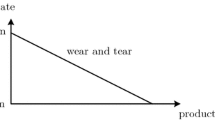Abstract
The specification of a product is frequently changed to satisfy new requirement from market buyers. To maintain market competitiveness, manufacturers must plan innovative production and sale strategies to achieve maximum benefit. This activity is known as innovative maintenance (IM). In this paper, we therefore consider a two-stage production-inventory model with replacement and imperfect component processes during which the components replacement is a common issue of IM. We then find the optimal production and sale strategies that minimize the total cost per unit time. An algorithm is proposed to find these optimal solutions. Finally, we quote two numerical examples from the Taiwan polyurethane industry to illustrate the proposed model and algorithm. Sensitivity analysis is also performed to obtain some managerial insights.








Similar content being viewed by others
References
Ben-Daya, M. (2002). The economic production lot-sizing problem with imperfect production processes and imperfect maintenance. International Journal of Production Economics,76, 257–264.
Chang, H. J., Su, R. H., Yang, C. T., & Weng, M. W. (2012). An economic manufacturing quantity model for a two-stage assembly system with imperfect processes and variable production rate. Computers & Industrial Engineering,63, 285–293.
Cheikhrouhou, N., Sarkar, B., Ganguly, B., Malik, A. I., Batista, R., & Lee, Y. H. (2018). Optimization of sample size and order size in an inventory model with quality inspection and return of defective items. Annals of Operations Research,271(2), 445–467.
Chen, Y. C. (2006). Optimal inspection and economical production quantity strategy for an imperfect production process. International Journal of Systems Science,37(5), 295–302.
Chen, S. C., Teng, J. T., & Skouri, K. (2014). Economic production quantity models for deteriorating items with up-stream full trade credit and down-stream partial trade credit. International Journal of Production Economics,155, 302–309.
Darwish, M. A., & Ben-Daya, M. (2007). Effect of inspection errors and preventive maintenance on a two-stage production inventory system. International Journal of Production Economics,107(1), 301–313.
Lee, H. H. (2008). The investment model in preventive maintenance in multi-level production systems. International Journal of Production Economics,112(2), 816–828.
Liao, G. L., Chen, Y. H., & Sheu, S. H. (2009). Optimal economic production quantity policy for imperfect process with imperfect repair and maintenance. European Journal of Operational Research,195(2), 348–357.
Nobil, A. H., Sedigh, A. H. A., & Cárdenas-Barrón, L. E. (2017). A multiproduct single machine economic production quantity (EPQ) inventory model with discrete delivery order, joint production policy and budget constraints. Annals of Operations Research. https://doi.org/10.1007/s10479-017-2650-9.
Pearn, W. L., Su, R. H., Weng, M. W., & Hsu, C. H. (2011). Optimal production run time for two-stage production system with imperfect processes and allowable shortages. Central European Journal of Operations Research,19, 533–545.
Sarker, B. R., Jamal, A. M. M., & Mondal, S. (2008). Optimal batch sizing in a multistage production system with rework consideration. European Journal of Operations Research,184, 915–929.
Taft, E. W. (1918). The most economical production lot. Iron Age,101, 1410–1412.
Taleizadeh, A. A. (2018). A constrained integrated imperfect manufacturing-inventory system with preventive maintenance and partial backordering. Annals of Operations Research,261, 303–337.
Taleizadeh, A. A., Kalantari, S. S., & Cárdenas-Barrón, L. E. (2016). Pricing and lot sizing for an EPQ inventory model with rework and multiple shipments. TOP,24, 143–155.
Taleizadeh, A. A., Niaki, S. T. A., & Najafi, A. A. (2010a). Multiproduct single-machine production system with stochastic scrapped production rate, partial backordering and service level constraint. Journal of Computational and Applied Mathematics,233(8), 1834–1849.
Taleizadeh, A. A., Sadjadi, S. J., & Niaki, S. T. A. (2011). Multi-product single-machine EPQ model with immediate rework process and back-ordering. European Journal of Industrial Engineering,5(4), 388–411.
Taleizadeh, A. A., Wee, H. M., & Jalali-Naini, S. G. (2013). Economic production quantity model with repair failure and limited capacity. Applied Mathematical Modeling,37(5), 2765–2774.
Taleizadeh, A. A., Weeb, H. M., & Sadjadi, S. J. (2010b). Multi-product production quantity model with repair failure and partial back-ordering. Computers & Industrial Engineering,59(1), 45–54.
Taleizadeh, A. A., Yadegari, M., & Sana, S. S. (2018). Production models of multiple products using a single machine under quality screening and reworking policies. Journal of Modelling in Management, 14(1), 232–259.
Teng, J. T., Lou, K. R., & Wang, L. (2014). Optimal trade credit and lot size policies in economic production quantity models with learning curve production costs. International Journal of Production Economics,155, 218–323.
Wang, H., & Pham, H. (1999). Some maintenance models and availability with imperfect maintenance in production systems. Annals of Operations Research,91, 305–318.
Wee, H. M., & Widyadana, G. A. (2011). Economic production quantity models for deteriorating items with rework and stochastic preventive maintenance time. International Journal of Production Economics,50(11), 2940–2952.
Weng, M. W., & Su, R. H. (2012). Determining the optimal production lot size for two-stage production system with allowable shortage, imperfect processes and rework. International Journal of Engineering and Industries,3(2), 53–64.
Yassine, N. (2018). A sustainable economic production model: Effects of quality and emissions tax from transportation. Annals of Operations Research. https://doi.org/10.1007/s10479-018-3069-7.
Author information
Authors and Affiliations
Corresponding author
Ethics declarations
Ethical statements
This paper complies with the provisions of ethical responsibilities of authors.
Additional information
Publisher's Note
Springer Nature remains neutral with regard to jurisdictional claims in published maps and institutional affiliations.
Rights and permissions
About this article
Cite this article
Su, RH., Weng, MW. & Huang, YF. Innovative maintenance problem in a two-stage production-inventory system with imperfect processes. Ann Oper Res 287, 379–401 (2020). https://doi.org/10.1007/s10479-019-03423-8
Published:
Issue Date:
DOI: https://doi.org/10.1007/s10479-019-03423-8




